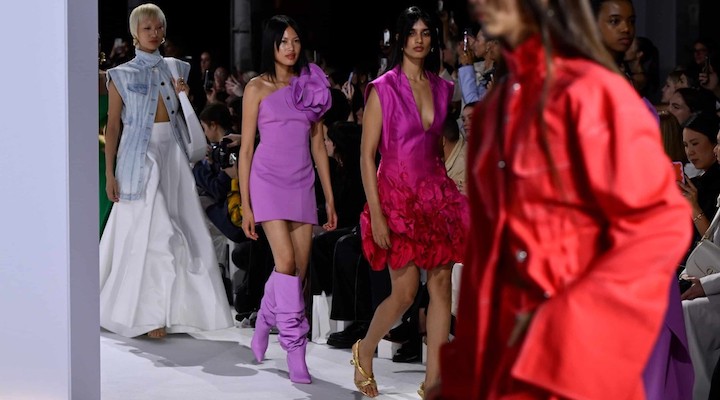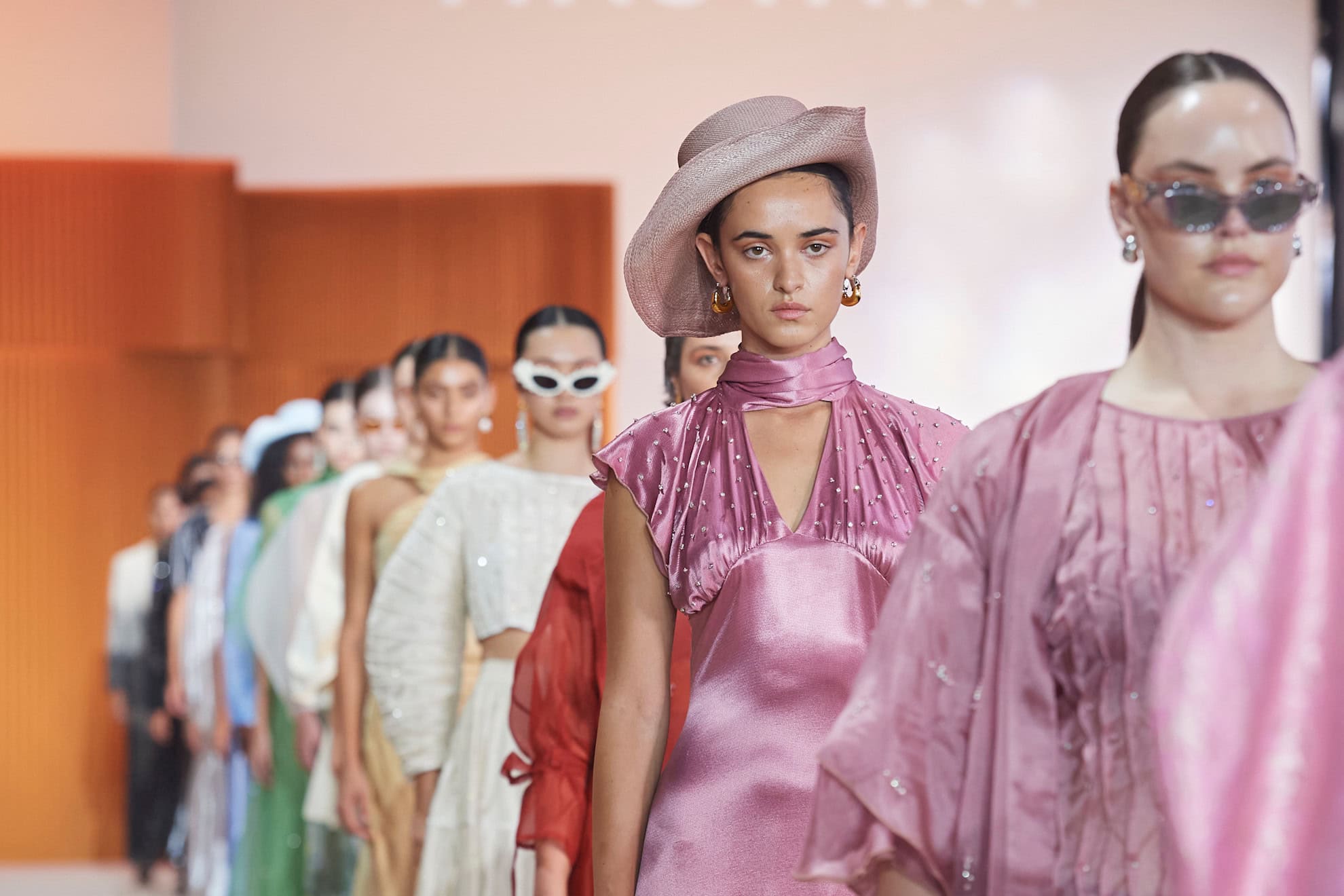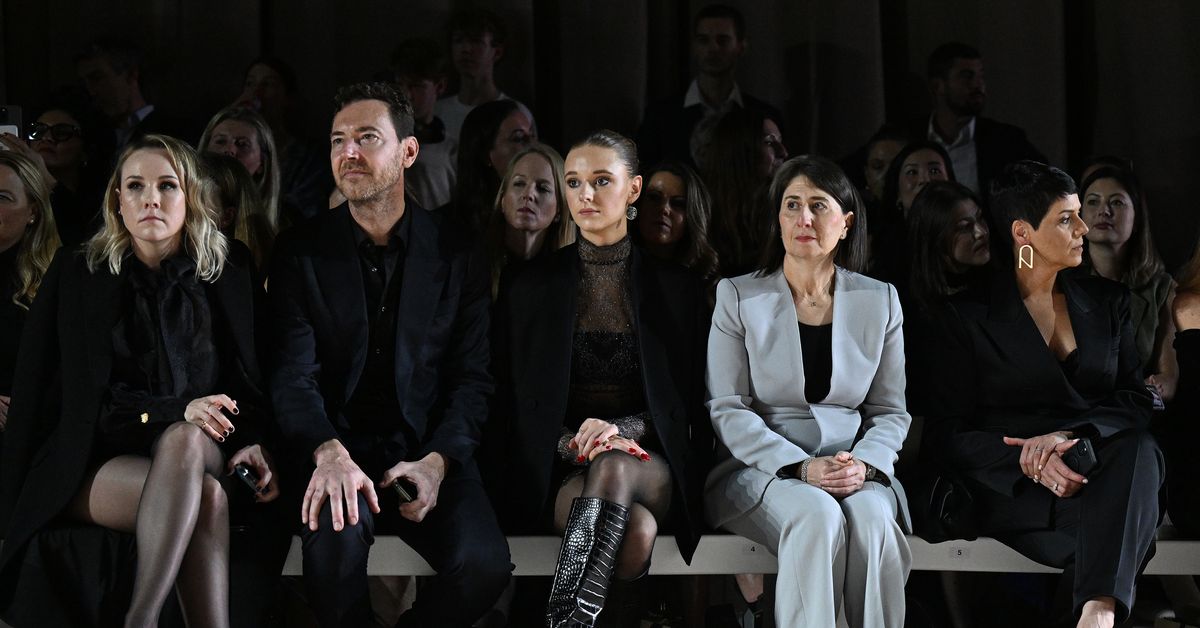Viktoria & Woods: an ode to the professional and the restful

- by Admin
- June 21, 2024

“It shall be comfortable, it shall be solid, it shall stand up to the wear and tear, and delight, it should be a pleasure to be in and work in,” the modernist Harry Seidler said of his architecture. The sentiment is no doubt shared by Margie Woods, whose show at Australian Fashion Week was held in the foyer of The Cove, one of the last apartment buildings Seidler designed.
Beneath The Cove’s famous 27-metre-high ceiling, guests sat in three long rows at the base of a staircase. As the first model descended onto the runway, wearing a flowing mauve pencil skirt and loose shirt in matching silky cupro – a derivative of viscose – the tone for the Viktoria & Woods collection was set. An ice-cool palette, airy fabrics that moved as though begging to be touched and silhouettes cut for a woman with places to be and no tolerance for discomfort.
Ever since its inception, the label has been dedicated to filling gaps in modern women’s wardrobes. “I’ve always felt like I wanted to reinterpret what the basic item is,” says Woods. “Essential wardrobe pieces with a contemporary edge that last, live forever and transcend seasons. Things that I felt were missing in the market.”
She founded Viktoria & Woods in Melbourne 20 years ago. The first pieces she designed were a merino-wool cardigan and a scoop-neck top in a few different colours. She took them in a suitcase to multi-brand boutiques she admired around the city and orders were placed before anyone had even tried them on. “It was an instant hit the second I took them out,” she says.
To mark the anniversary of the brand, which has 17 standalone stores across the country, concessions in nine David Jones stores and a presence in international retailers, Woods felt it was time for a debut show at Australian Fashion Week.
She is pragmatic about the difficulties designers are facing in the Australian fashion landscape, noting the recent closures of Melbourne peers Arnsdorf and A.BCH, which were also committed to local manufacturing, as well as Sydney-based Dion Lee. “We feel strong to be where we are and to have gotten this far,” she says. “We’re in the right place.”
Each collection she releases this year will be under the title Reflections of Light. The latest one, Resort 2025, which will arrive in stores in October, is called Solar. For Woods, the sun is a prompt for dreaming about the future – she and her team started by asking themselves, What does the future look like? What do we want to feel? What do we want to be doing? “The light becomes a source of inspiration,” she says.
At the show, this light is present on the runway – it beams down from a narrow floor-to-ceiling window at one end, where the models start their walk. It catches the fluidity of silk, the sheen of leather and the ripple of long tassels.
One look is entirely pastel green. A soft trench that falls below the knee, made from the same soft tailored fabric as the accompanying oversized Bermuda shorts. The shorts are cinched at the waist with a matching belt, but slouch across the hips with several well-placed pleats that create ease of movement between the pockets on either hip. A shiny cupro shirt in a similar shade is tucked into the shorts. Below them the model wears a pair of nude, knee-high, pleather socks with a matching pair of strappy, heeled sandals. It’s a styling choice that’s repeated across outfits in various colours, giving an edge to clothes that otherwise might simply be smart – or worse, normal.
Another model wears bright red opaque tights and red strappy sandals with the slouchy trench in beige. Beneath it is a soft, chocolate-brown bustier and pencil skirt made from a stretchy, double-layered mesh. The seams of the corset and the skirt are prominent and give definition to the silhouette through a series of simple horizontal and vertical lines. The model carries an oversized black leather bag that’s too big to be a clutch but is held like one anyway. This look has sexiness, as well as a sense of purpose and authority.
“We’ve been doing corsets for many, many years,” says Woods. “I love underwear and mixing feminine with masculine.” The corset is one of the pieces she reaches for whenever she doesn’t know what to wear. “It just makes women feel sexy but pulled in and secure. So many of my friends of all ages, shapes and sizes love it for that reason.”
This ability to understand how women want to feel when they get dressed has informed several of the bestselling styles Woods describes as core products or “that new magic piece that becomes famous”. They are fundamental to the survival of the business: “I can’t imagine any brand who’s successful without core products. I really can’t,” she says.
Over time, these products evolve. They are made in different fabrics with slight tweaks and feature season after season. Among them are a pant made from satin with an elasticated waist and a matching shirt. Tailored trousers and blazers that manage to be oversized but with feminine lines and, of course, the knitwear that started the brand.
In Solar, the knitwear offers a relaxed contrast to the earlier pieces that evoke a professional woman on the move. They are fine-merino sets consisting of high-waisted micro shorts, cardigans, singlets and oversized jumpers that conjure images of slow afternoons padding barefoot around the house, between the couch, a bookshelf and the kitchen for a cup of tea. While the tops could be worn with jeans, skirts and tailored pants to meetings and social engagements, the styling on the runway speaks to a woman who needs downtime between work and events, someone with a rich interior life.
Revealing the depth of her resolve in what the brand stands for, a few years ago Woods invested $130,000 in a knitting machine to support one of her makers. The machine is emblematic of her commitment to local manufacturing as well as her love of merino wool. She made the decision when Australian garment makers were suffering, because it would always give her the ability to make at least 4000 garments a year onshore. “It’s allowed us to keep production here and to maintain the quality and the look and feel that I wanted, which I would not have been able to do elsewhere,” she says.
Almost all of the collection is still made in Australia, with the exception of the leather pieces, which are produced in Turkey. These pieces are the most structured on the runway: well-cut pencil skirts, shift dresses and a floor-length strapless gown offer contrasts to the fluidity of the other silhouettes.
The precise architecture of each one is an actualisation of Seidler’s words: it shall be solid, it shall stand up to the wear and tear. All speak to the resilience required of a professional woman, just as the other garments on the runway address the complementary need for comfort, pleasure and delight – a formula that suits Margie Woods.
This article was first published in the print edition of The Saturday Paper on
June 22, 2024 as “Light and movement”.
For almost a decade, The Saturday Paper has published Australia’s leading writers and thinkers.
We have pursued stories that are ignored elsewhere, covering them with sensitivity and depth.
We have done this on refugee policy, on government integrity, on robo-debt, on aged care,
on climate change, on the pandemic.
All our journalism is fiercely independent. It relies on the support of readers.
By subscribing to The Saturday Paper, you are ensuring that we can continue to produce essential,
issue-defining coverage, to dig out stories that take time, to doggedly hold to account
politicians and the political class.
There are very few titles that have the freedom and the space to produce journalism like this.
In a country with a concentration of media ownership unlike anything else in the world,
it is vitally important. Your subscription helps make it possible.
The Latest News
-
November 15, 2024Australian bounce India’s arch-enemy amid KL Rahul dilemma
-
November 15, 2024Nick Kyrgios set to make long-awaited return to tennis as comeback date revealed
-
November 15, 2024List wins elusive DP World Tour card, Barron loses his
-
November 15, 2024India great warns ‘the king is back in his territory’ as struggling Virat Kohli returns for fifth tour
-
November 15, 2024‘Adaptable’ Murphy spins out WA to put Vics in control | cricket.com.au





